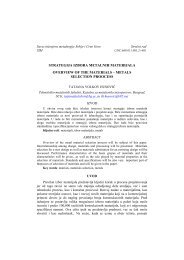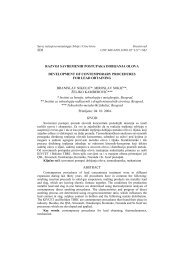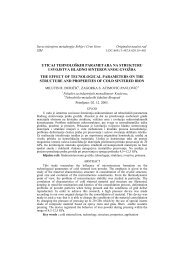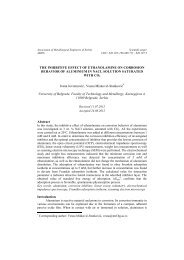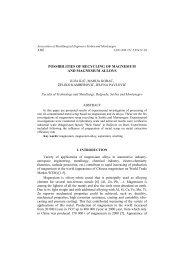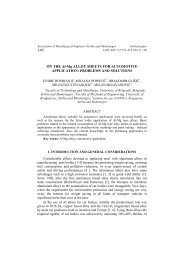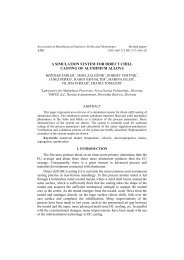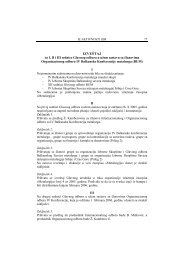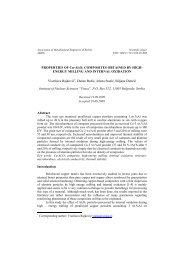ferrous metallurgy center of the brnjica cultural group - CEON
ferrous metallurgy center of the brnjica cultural group - CEON
ferrous metallurgy center of the brnjica cultural group - CEON
Create successful ePaper yourself
Turn your PDF publications into a flip-book with our unique Google optimized e-Paper software.
108<br />
MJoM<br />
METALURGIJA - JOURNAL OF METALLURGY<br />
Fig 10<br />
In short, during <strong>the</strong> archaeological excavations in <strong>the</strong> part <strong>of</strong> <strong>the</strong> Hisar site in<br />
Leskovac, in <strong>the</strong> oldest stratum <strong>of</strong> <strong>the</strong> Brnjica <strong>cultural</strong> <strong>group</strong> (<strong>the</strong> middle <strong>of</strong> <strong>the</strong> 14 th<br />
century BC) were found: <strong>ferrous</strong> cast <strong>of</strong> several kilograms, amorphous iron, <strong>ferrous</strong><br />
artefacts, slag, remains <strong>of</strong> numerous smelting furnaces, charcoal pits, ceramic air<br />
blowing pipes (Figure 10), millstones with traces <strong>of</strong> ore grinding; consequently, all<br />
<strong>the</strong> finds confirm <strong>the</strong> existence <strong>of</strong> a <strong>ferrous</strong> <strong>metallurgy</strong> and handicrafts <strong>center</strong> at <strong>the</strong><br />
Hisar site, based on iron.<br />
The <strong>ferrous</strong> artefacts in a form <strong>of</strong> “shafts” or “spits”, similar to <strong>the</strong> “needles”<br />
from <strong>the</strong> Hisar site in Leskovac, found in larger numbers at one spot (<strong>the</strong> Lower<br />
Danube, Peloponnesus, Middle East) are considered to represent <strong>the</strong> (pre–monetary)<br />
payment means, expensive presents or, possibly, votive presents [7]. The oldest<br />
<strong>ferrous</strong> artefacts in <strong>the</strong> Middle East very <strong>of</strong>ten are in a form <strong>of</strong> a chisel, similar to <strong>the</strong><br />
chisel from <strong>the</strong> Hisar slag structure [8]. The iron production in <strong>the</strong> Middle East<br />
during <strong>the</strong> second half <strong>of</strong> <strong>the</strong> second millennium BC, as well as <strong>the</strong> distribution<br />
<strong>the</strong>re<strong>of</strong>, particularly <strong>of</strong> finished artefacts, was under <strong>the</strong> strict control <strong>of</strong> rulers, as<br />
confirmed in <strong>the</strong> written documents <strong>of</strong> <strong>the</strong> time [9]. It may be assumed that <strong>the</strong>re<br />
was no kept evidence <strong>of</strong> <strong>the</strong> “royal metal” expenditures at <strong>the</strong> Hisar settlement in<br />
Leskovac, that <strong>the</strong>re was no iron inventory as had been kept by <strong>the</strong> Hittites or <strong>the</strong><br />
Assyrians, but it is quite certain that <strong>the</strong> leading personality <strong>of</strong> <strong>the</strong> South Morava<br />
river basin society living in <strong>the</strong> settlement, had taken care <strong>of</strong> <strong>the</strong> production and<br />
distribution <strong>of</strong> iron and <strong>ferrous</strong> artefacts as well as that he had seen to it that <strong>the</strong><br />
metallurgic secret <strong>of</strong> production <strong>of</strong> <strong>the</strong> “metal, more expensive than gold” remained<br />
under his monopoly, <strong>the</strong> same as had done <strong>the</strong> powerful Hittite and Mesopotamian<br />
rulers.<br />
The Rajkinac axe, <strong>ferrous</strong> artefacts traces from Stari Kostolac, <strong>the</strong> iron fibula<br />
from <strong>the</strong> Gornja Stražava urn and <strong>the</strong> <strong>ferrous</strong> artefacts from Leskovac are <strong>the</strong> oldest<br />
<strong>ferrous</strong> artefacts in <strong>the</strong> central Balkan region, pointing to <strong>the</strong> fact that iron was<br />
utilized by all <strong>the</strong> communities from <strong>the</strong> area during <strong>the</strong> 14 th –13 th (12 th ) centuries BC<br />
[10]. All <strong>the</strong> <strong>ferrous</strong> artefacts have <strong>cultural</strong> and chronologic context. The Rajkinac<br />
axe belongs to <strong>the</strong> Paraćin <strong>cultural</strong> <strong>group</strong>, Leskovac and Gornja Stražava artefacts –<br />
to <strong>the</strong> Brnjica <strong>cultural</strong> <strong>group</strong>, while <strong>the</strong> Stari Kostolac artefacts – belong to <strong>the</strong><br />
Belegiš II <strong>cultural</strong> <strong>group</strong>, that is, most probably to <strong>the</strong> <strong>cultural</strong> manifestation<br />
characterized by a mixture <strong>of</strong> yellow hill ceramics and cannelured ceramics <strong>of</strong><br />
Belegiš II type – Gava. In short, <strong>the</strong>se artefacts prove <strong>the</strong> use <strong>of</strong> <strong>ferrous</strong> artefacts <strong>of</strong><br />
all <strong>the</strong> central Balkan communities during <strong>the</strong> period <strong>of</strong> 14 th –13 th (12 th ) centuries<br />
BC.




